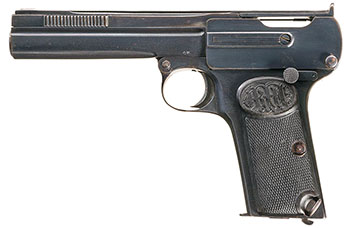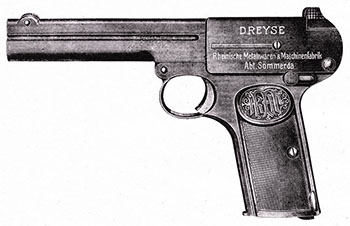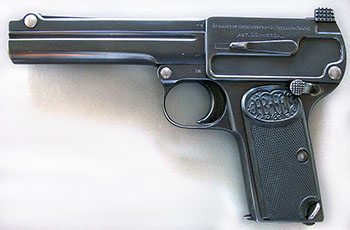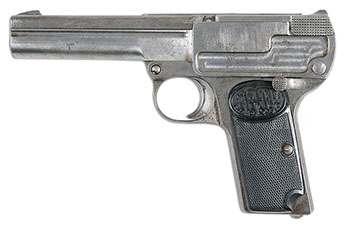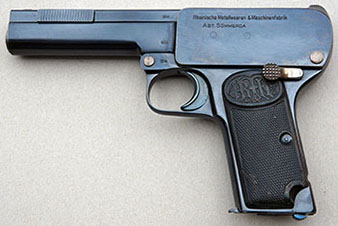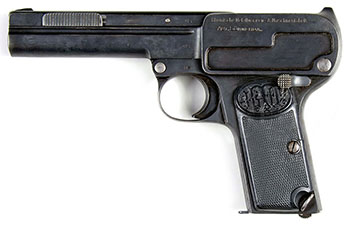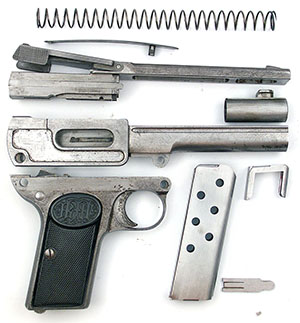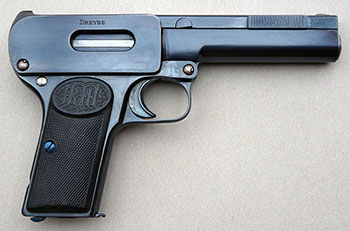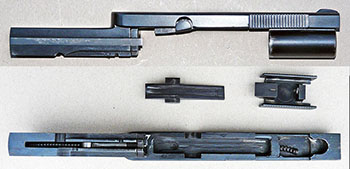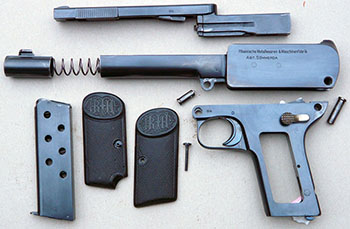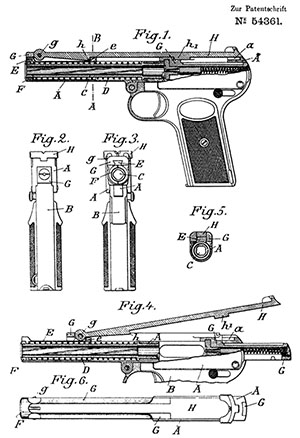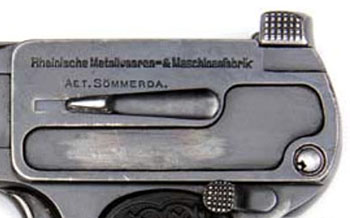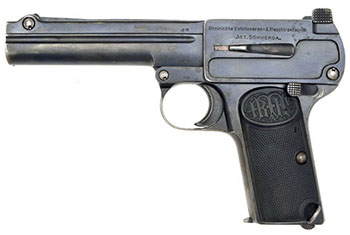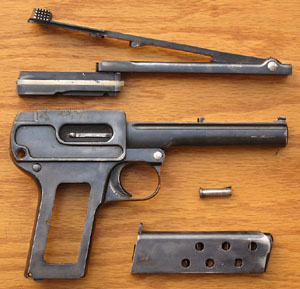 |
|||||||||||||||||||||||||||||||||||||||||||||||||||||||||||||||||||||||||||||||||||||||||||||||||||||||||||||||||||||||||||||||||||||||||||
|
The 1910 Dreyse 9mm Pistol
J. Howard Matthews, in his book Firearms Identification, refers to the Dreyse 9mm pistol as the Model 1910, though an article in the 20 January 1912 Der Waffenschmied calls the gun a Model 1911. It is also known as the Dreyse Armeepistole. Like the Model 1907 Dreyse pistol in 7.65mm Browning, the Model 1910 pistol in 9mm Parabellum was designed by Louis Schmeisser for Rheinische Metallwaaren & Maschinenfabrik (RM&M). The exact date of the first design is not known, but it seems likely that Schmeisser began work on the more powerful pistol soon after production for the Model 1907 had begun, and clearly the larger gun was based on the earlier design. Two versions of the Model 1910 were made, and a number of prototypes of varying design were created in the process. One of the earliest prototypes must be the unnumbered blued gun shown above with serrations at the front of the slide and a cutout area in the upper frame housing. This gun apparently has no lock or delay mechanism for the slide. The reason for the cutout is not apparent. Note that this gun has a screw to secure the ejector at the rear, and the rear grip-strap is
Another early prototype is the unnumbered in-the-white one, shown above and at right. (In recent years this gun has been marked with the number 7B). The rear lever, hinged just above the breech, is held in place by a flat arm of spring steel, which must be removed in order to lift the lever and retract the slide. The mechanism is described by Göertz and Sturgess as follows: “A single specimen of a second delayed blow-back type exists, an in-the-white prototype utilising a long flexible steel spring arm over the bolt to load an angled cam against opening of the action; as with the normal production weapon, this can be lifted up when first loading the pistol to allow the bolt to be withdrawn.” However, this description is inaccurate. The gun has a straight blowback action with no delay mechanism, as can be seen in the photograph of it disassembled. The “Delayed Blowback” Version This version has a delayed blowback mechanism
The rocker bears a vague
In his Deutsches Waffen-Journal article of 1989, Tillig states: “It is incomprehensible why Louis Schmeisser did not patent and manufacture this pistol.” Tillig briefly speculates that perhaps the patent was too similar to one held by Mauser, or possibly the system was not reliable enough for a military weapon. It does not appear that this version was ever tested by the Landsgendarmerie (see section below on the production version)–the test notes, excerpts from which are provided in the Göertz and Sturgess book, do not mention this design.
The Production Version
According to Göertz’s and Sturgess’ book Borchardt & Luger Automatic Pistols, the German Rural Constabulary (Landgendarmerie) were already familiar with the Model 1907 Dreyse, and decided to test the 9mm Dreyse against the P08 Luger and a modified “self-cocking” or double action Model 1883 Revolver. The Model 1910 Dreyse was tested in December 1910 and again in March 1911, and the gun tested was likely very similar to that shown in the ALFA catalog of 1911, with a screw on the left side of the upper housing to hold the ejector in place. However, the heavy recoil of the gun caused the screw to come loose, so later versions of the design have the ejector press-fit into the housing. During testing by the Landsgendarmerie, a number of changes were made to the design, including upping the barrel rifling lands from 4 to 6 to increase accuracy, heightening the front sight, widening the trigger, eliminating the ejector screw, redesigning the pins at the pivot points so as not to work loose under recoil, strengthening the walls of the magazine, and increasing the power of the magazine spring. During testing late in May of 1911, four jams were noted, which were attributed by RM&M to faulty ammunition. Göertz and Sturgess comment: “There was no suggestion that the deformation of the cases was caused by the unsupported parts of the case being subjected to excessive internal breech pressures because of the early opening of the blowback action, but...the Dreyse view was that the cases should be reinforced to counter this problem.” RM&M stated they would make their own ammunition for the pistol in future, and a few rare boxes of this ammunition have apparently surfaced in the cartridge collecting community (see RM&M 9mm Ammo). Ultimately the Dreyse was recommended for adoption by the Landgendarmerie over the P08 Parabellum (Luger) pistol. It was noted that while both guns were complicated to disassemble, the men were already familiar with the 1907 Dreyse. The safety of the Dreyse was considered superior, as were the safety markings, and the magazine was reported easier to load. The double-action M83 Reichsrevolver was given short shrift.
Göertz and Sturgess state: “In the 1912 edition of the annual “Thüringschen Waffenindustrie” it was reported that nearly all police forces in Germany were going to buy the pistol, and that the Prussian Finance Ministry had ordered 2700 of them to equip the Border Customs officers. However, as it turned out, the Rheinmetall company at Sommerda...were unable to produce any significant numbers of working pieces, causing the Gewehr-Prufungskommission in 1913 finally to declare the whole design not to be war-worthy.” The gun appears in the 1913-14 AKAH catalog as well as in the 1914 GECO catalog, which were likely already in preparation by the time the gun was determined to be unworkable. Serial numbers began with 1001. Most known specimens have serial numbers between 1001 and 1531, with a few in the low 3000’s. Hence total production is estimated at less than 600 guns. I would very much appreciate hearing from readers who own these guns, so that I can collect more serial number information and more accurately describe known variants.* Description of the Production Mechanism
There is a second lug on the bottom of the retractor plate which engages a spring-loaded plunger in the top of the breech block. This plunger locks the striker when the slide retractor plate is open–this prevents the gun from being fired when the slide retractor is not locked in place on top of the gun. Like the Model 1907, the upper receiver housing is hinged at the front and can be lifted up from the lower receiver. However, the 9mm does not have a latch at the back to unlock the upper housing. The pistol has stout pins that secure the upper receiver to the lower receiver both front and rear. The pins have a built-in spring to retain them. A similar pin at the front attaches the slide retractor plate to the slide.
Sights are integral with the slide retractor plate. Ejection is to the right through a port in the upper receiver housing. The extractor is made of spring steel and fits in a slot on the right side of the breech block. The ejector is press fit into the left side of the upper receiver. On the exterior the ejector forms what looks like a lever, but it is not movable and serves no apparent purpose. A rotating manual safety lever on the left rear side of the upper receiver locks the sear when engaged. A pin on the back of the striker protrudes through a hole in the back of the receiver when the striker is cocked. The slide locks open on the last round–held open by the magazine follower–but the slide is released when the magazine is withdrawn. There is a lanyard loop at the base of the left grip. The left side of the upper receiver housing is marked in sans-serif characters as follows: Rheinische Metallwaaren- & Maschinenfabrik The right side is marked just above the ejection port in serif characters: DREYSE Serial numbers are found on the bottom of the breech block (visible when the slide is locked open) and on the frame just in front of the front hinge. Some magazines are numbered to the gun, and some are not. * Write to edbuffaloe@unblinkingeye.com. |
|||||||||||||||||||||||||||||||||||||||||||||||||||||||||||||||||||||||||||||||||||||||||||||||||||||||||||||||||||||||||||||||||||||||||||
|
|||||||||||||||||||||||||||||||||||||||||||||||||||||||||||||||||||||||||||||||||||||||||||||||||||||||||||||||||||||||||||||||||||||||||||
|
Copyright 2011-2020 by Ed Buffaloe. All rights reserved. |
|||||||||||||||||||||||||||||||||||||||||||||||||||||||||||||||||||||||||||||||||||||||||||||||||||||||||||||||||||||||||||||||||||||||||||
|
|
|||||||||||||||||||||||||||||||||||||||||||||||||||||||||||||||||||||||||||||||||||||||||||||||||||||||||||||||||||||||||||||||||||||||||||
